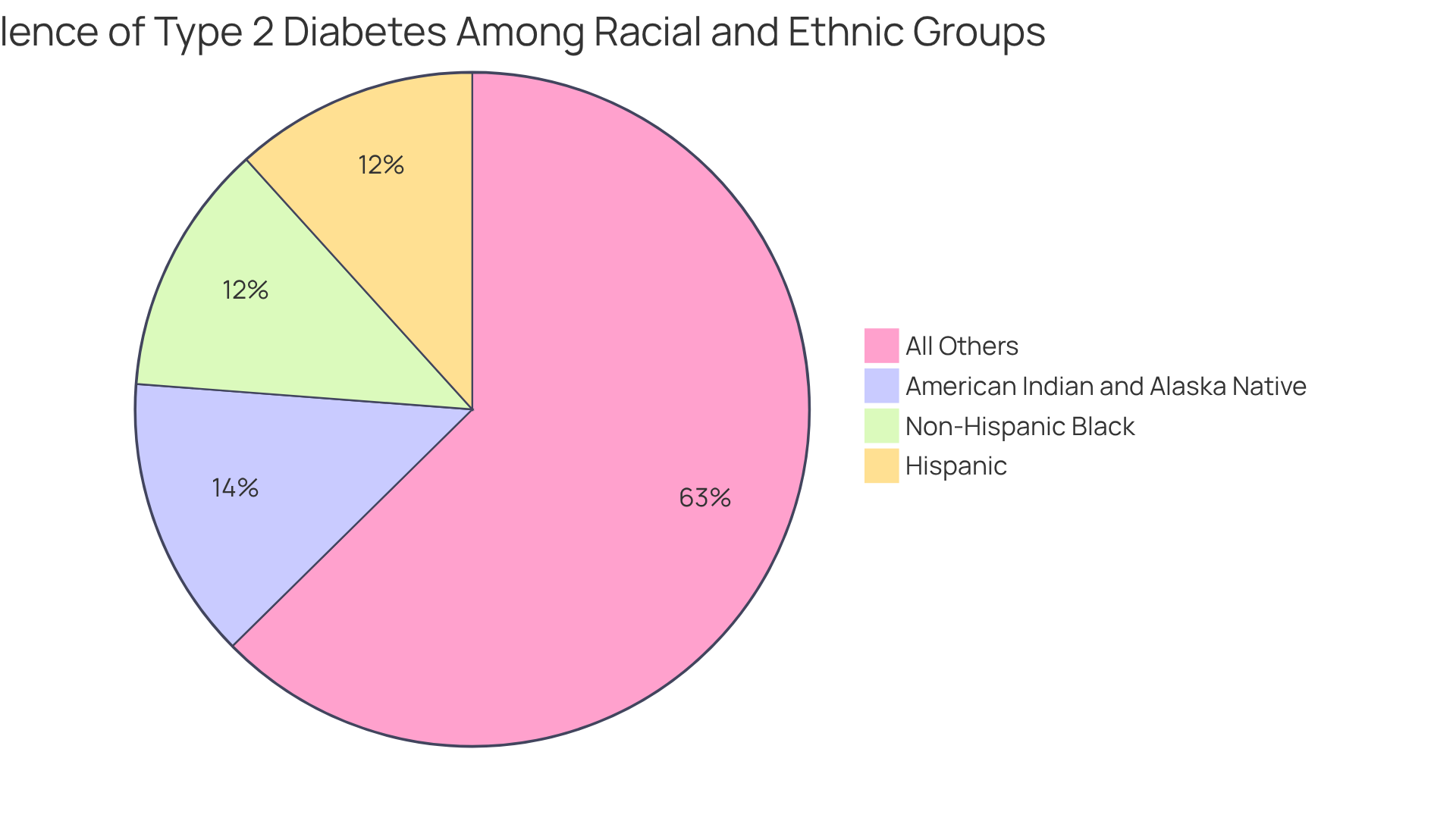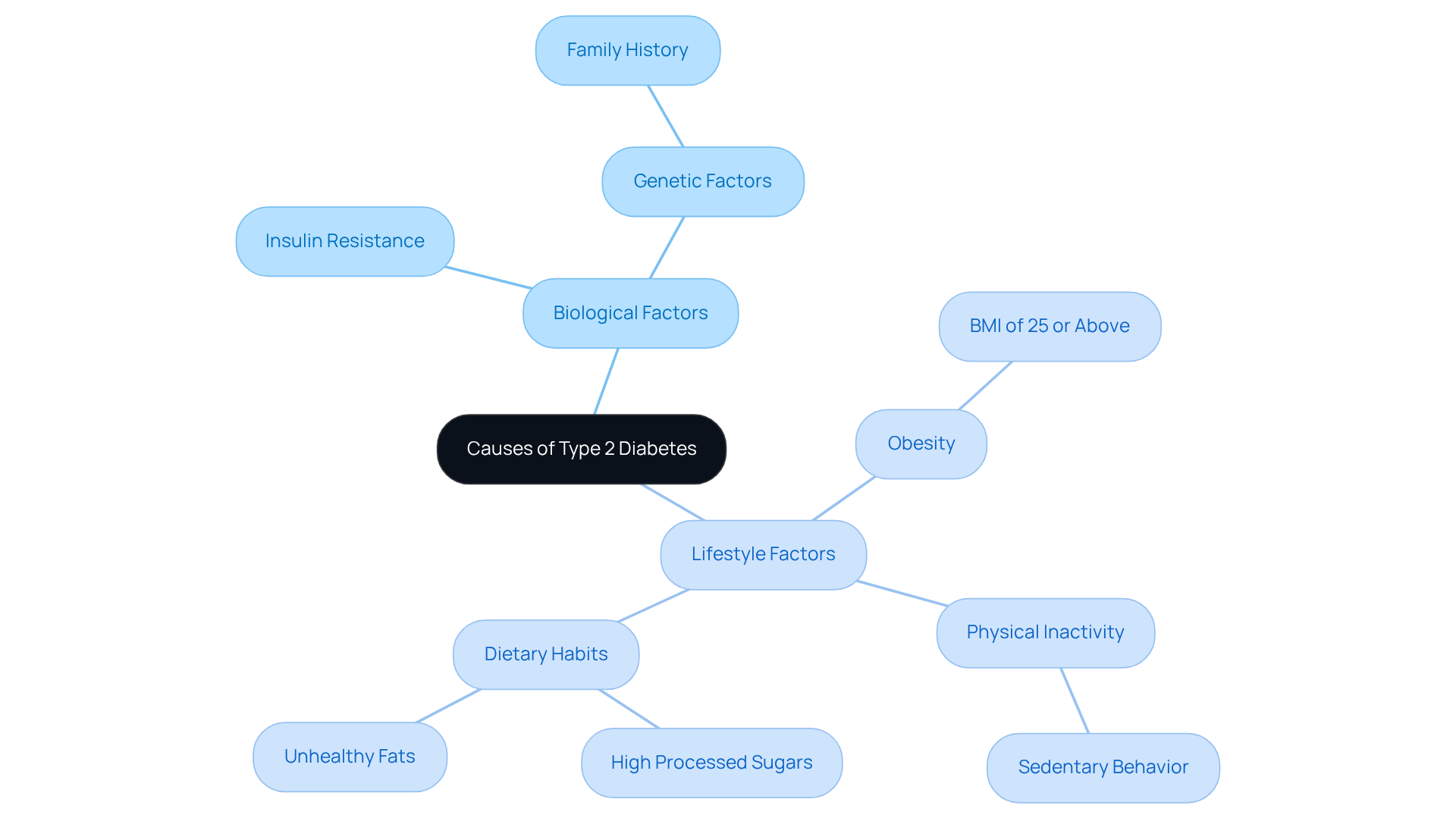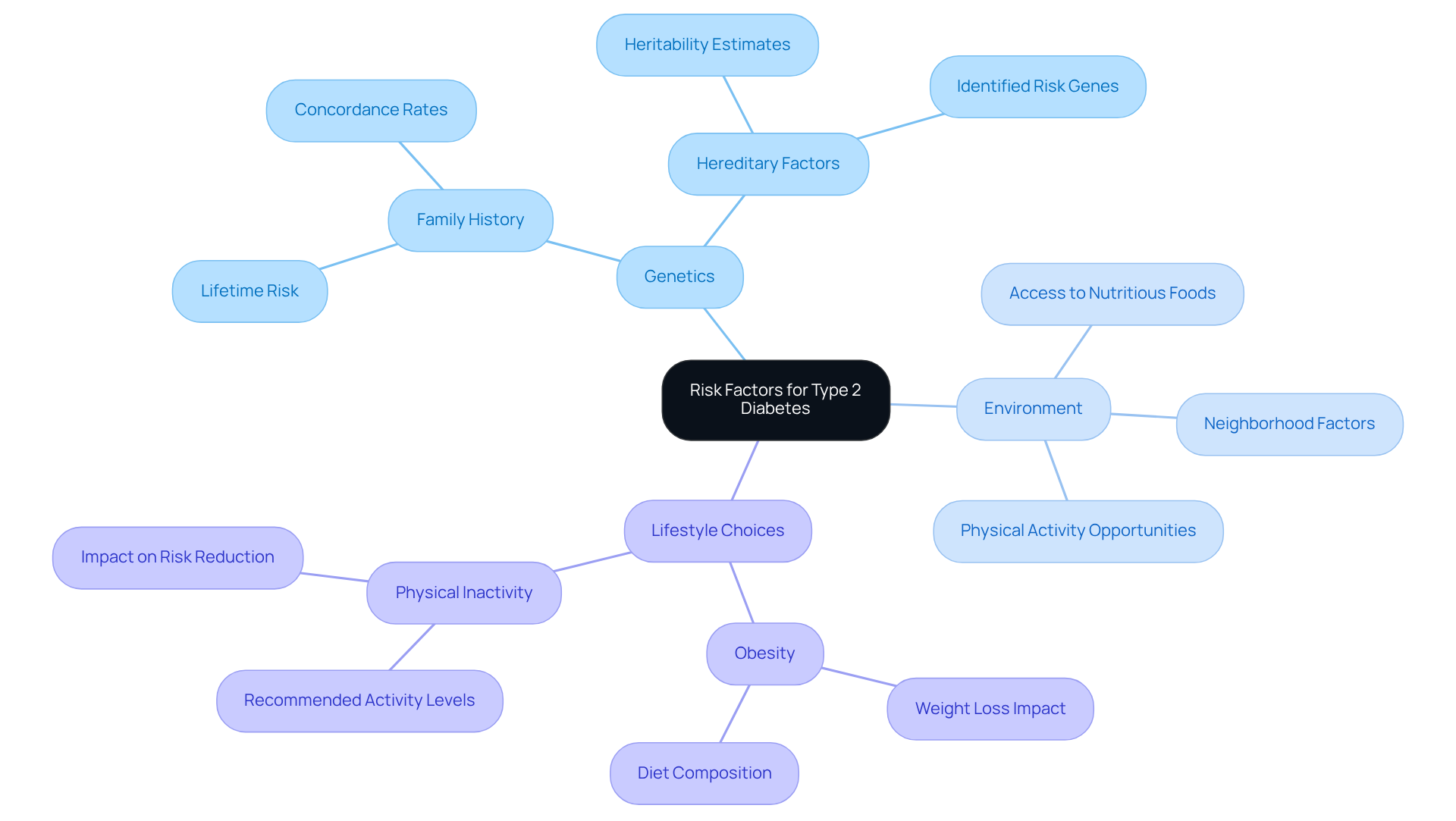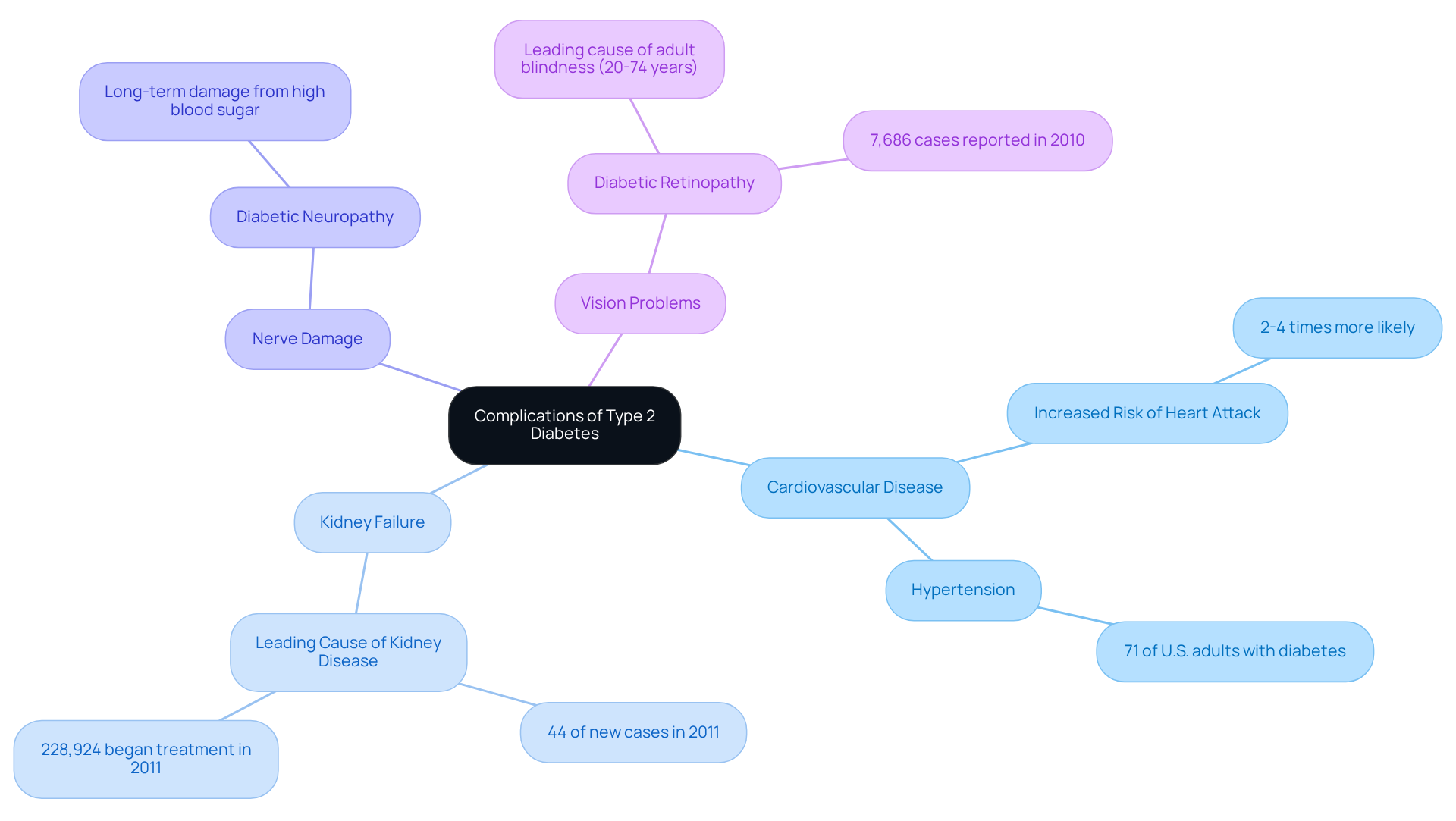Overview
Type 2 diabetes often arises from a blend of genetic factors, insulin resistance, and lifestyle choices, including obesity and inactivity. It's understandable to feel overwhelmed by this information, but know that you're not alone in your journey. Understanding how these elements connect can empower you. By managing your weight, engaging in regular physical activity, and making healthier dietary choices, you can significantly reduce your risk of developing this condition. Remember, we are here to support you every step of the way as you take these important steps toward better health.
Introduction
Understanding the growing prevalence of Type 2 Diabetes reveals a complex interplay of biological, lifestyle, and environmental factors that contribute to this chronic condition. With nearly 38.4 million Americans affected, the urgency to unravel the reasons behind its rise has never been greater. It's understandable to feel overwhelmed by this statistic.
What drives individuals toward this diagnosis, and how can they navigate the risks associated with it? Exploring the causes, risk factors, and long-term implications of Type 2 Diabetes not only sheds light on this pressing health issue but also empowers individuals to make informed choices for a healthier future.
You're not alone in this journey, and we are here to support you every step of the way.
Understand Type 2 Diabetes: Definition and Overview
Condition 2 is a long-term ailment characterized by high blood sugar levels due to insulin resistance and insufficient insulin production. Unlike the first form, where the body completely lacks insulin production, the second form shows a gradual decrease in insulin sensitivity and secretion. This condition typically develops over several years, prompting inquiries into why do people get type 2 diabetes, and is closely linked to obesity, sedentary lifestyles, and unhealthy dietary choices.
It's understandable to feel overwhelmed by the statistics surrounding this condition. Currently, approximately 38.4 million individuals in the U.S. are affected, which represents 11.6% of the population. Among these, the second variety of diabetes is the most common form, with significant disparities across various racial and ethnic groups. For example, the prevalence is highest among American Indian and Alaska Native adults at 13.6%, followed by non-Hispanic Black adults at 12.1% and Hispanic adults at 11.7%.
Comprehending the meaning and traits of Condition 2 is crucial, as it highlights the intricate nature of managing this illness. Effective management strategies can help answer the question of why do people get type 2 diabetes, and these include lifestyle modifications such as maintaining a healthy weight, engaging in regular physical activity, and adhering to a balanced diet. Recent studies suggest that at least 150 minutes of moderate activity each week can significantly lower the likelihood of developing a form of diabetes, which raises the question of why do people get type 2 diabetes.
Moreover, early diagnosis and intervention are critical, as symptoms may take years to manifest. It’s important to recognize that this condition can lead to severe complications, including cardiovascular disease, kidney failure, and vision impairment. Thus, continuous education and assistance are essential elements of managing Condition 2, enabling individuals to make informed health choices and enhance their quality of life.
At T2DSolutions, we are dedicated to offering resources and assistance for individuals recently diagnosed with the second type of this condition. You're not alone in this journey. We encourage you to explore our platform for valuable information, community support, and tools to help you manage your condition effectively. Together, we can navigate the challenges of managing this condition.

Identify Causes: Biological and Lifestyle Factors
Understanding why do people get type 2 diabetes can feel overwhelming, as the causes stem from a combination of biological and lifestyle factors. One significant biological contributor is insulin resistance, which occurs when the body's cells struggle to respond effectively to insulin. This can lead to elevated blood sugar levels. Additionally, genetic factors play a crucial role; those with a family history of blood sugar issues have a higher likelihood of developing the condition. For instance, if one parent has diabetes, the chance of their child facing the same challenge increases to about 50%.
It's important to recognize how lifestyle choices intertwine with these biological factors. Obesity, particularly with a body mass index (BMI) of 25 or above, significantly contributes to insulin resistance. Sedentary behavior, characterized by long periods of inactivity, is another key factor. Research indicates that physical inactivity can raise the risk of developing Type 2 Diabetes, especially for adults aged 35 and older.
Dietary habits also play a vital role in this equation. Diets high in processed sugars and unhealthy fats can lead to weight gain and worsen insulin resistance. For example, individuals consuming large amounts of sugary drinks face an increased risk of obesity and, consequently, Type 2 Diabetes.
Understanding why do people get type 2 diabetes and the multifaceted causes is essential for developing effective prevention and management strategies. By addressing both biological predispositions and lifestyle choices, you can take proactive steps to reduce your risk and enhance your overall health. Remember, you're not alone in this journey; we are here to support you every step of the way.

Examine Risk Factors: Genetics, Environment, and Lifestyle Choices
Understanding the risk factors for developing Type 2 Diabetes is essential to grasping why do people get type 2 diabetes, which can be a crucial step in your health journey. Understanding why do people get type 2 diabetes is important, as a mix of genetic, environmental, and lifestyle elements contribute to this condition.
If you have a family history of diabetes, you may understandably feel concerned about why do people get type 2 diabetes, since genetics plays a significant role in your risk. Environmental factors, such as access to nutritious foods and opportunities for physical activity, are important in understanding why do people get type 2 diabetes. For instance, living in a neighborhood with limited grocery store access can lead to challenging dietary choices.
Lifestyle choices are essential in understanding why do people get type 2 diabetes, particularly in relation to obesity and physical inactivity. These are modifiable factors that you can address. By embracing consistent physical activity and a nutritious diet, you can greatly reduce your chances of developing Type 2 Diabetes, which leads to the question of why do people get type 2 diabetes. This highlights the importance of making lifestyle changes, and it’s never too late to start.
At T2DSolutions, we understand that navigating these challenges can be overwhelming. We serve as a valuable resource center, offering educational materials and community support tailored to help newly diagnosed patients like you. You're not alone in this journey; we are here to support you every step of the way. Together, we can work towards making effective lifestyle adjustments that can lead to a healthier future.

Explore Consequences: Complications and Long-term Health Implications
It's understandable to feel concerned about your health when considering the severe and far-reaching consequences of unmanaged Type 2 Diabetes, which leads many to wonder why do people get type 2 diabetes. Long-term complications, such as cardiovascular disease, kidney failure, nerve damage, and vision problems like diabetic retinopathy, can arise from prolonged high blood sugar levels. These elevated levels can damage blood vessels and nerves throughout the body, which is why it's so important to be aware of the risks.
For instance, individuals with high blood sugar face an increased risk of heart disease due to the impact of elevated glucose levels on blood vessel health. In fact, those with diabetes are 2 to 4 times more likely to experience a heart attack or stroke compared to those without the condition. Recognizing these risks highlights the significance of effective management strategies for blood sugar control. Regular monitoring, medication adherence, and lifestyle changes are important in understanding why do people get type 2 diabetes and can help prevent or postpone the emergence of these serious health issues.
It's also important to understand that diabetes is the leading cause of newly diagnosed adult blindness for individuals aged 20 to 74 years. In 2010 alone, over 7,686 cases of diabetic retinopathy were reported in the United States. Moreover, the condition was responsible for 44 percent of new kidney failure cases in 2011, emphasizing the critical need for effective management. Remember, you're not alone in this journey; support is available to help you navigate these challenges.
Additionally, it's crucial to note that 50 percent of people with diabetes die from cardiovascular disease. This statistic underlines the urgency of addressing these health risks. We are here to support you every step of the way, and seeking resources or assistance can make a significant difference in your management of diabetes.

Conclusion
Understanding the complexities of Type 2 Diabetes is essential for grasping why this condition affects millions of individuals. This article sheds light on the multifaceted nature of Type 2 Diabetes, emphasizing that its development is not solely a result of one factor but rather a combination of biological predispositions, lifestyle choices, and environmental influences. By recognizing the intricate interplay of these elements, you can better navigate your health journey and make informed decisions.
Key insights discussed include:
- The significant role of insulin resistance
- Genetic factors
- Lifestyle choices such as diet and physical activity in the onset of Type 2 Diabetes
Alarming statistics regarding the prevalence of this condition across various demographics highlight the importance of early diagnosis and proactive management strategies. It's understandable to feel overwhelmed, but making lifestyle changes—such as maintaining a healthy weight and engaging in regular exercise—can significantly reduce the risk of developing diabetes and its associated complications.
Ultimately, the message is clear: awareness and education are crucial in combating Type 2 Diabetes. By understanding the causes, risk factors, and potential complications, you can take actionable steps toward prevention and management. Embracing a healthier lifestyle is not just a personal choice; it is a vital step toward enhancing your overall well-being. Remember, support and resources are available for you as you navigate this journey, reinforcing the notion that you are not alone in facing the challenges of Type 2 Diabetes.
Frequently Asked Questions
What is Type 2 Diabetes?
Type 2 Diabetes is a long-term condition characterized by high blood sugar levels due to insulin resistance and insufficient insulin production. Unlike Type 1 Diabetes, where there is a complete lack of insulin production, Type 2 shows a gradual decrease in insulin sensitivity and secretion.
What are the common causes of Type 2 Diabetes?
Type 2 Diabetes is closely linked to obesity, sedentary lifestyles, and unhealthy dietary choices. These factors contribute to the development of the condition over several years.
How prevalent is Type 2 Diabetes in the U.S.?
Approximately 38.4 million individuals in the U.S. are affected by Type 2 Diabetes, which represents 11.6% of the population. It is the most common form of diabetes, with varying prevalence across different racial and ethnic groups.
Which racial and ethnic groups have the highest prevalence of Type 2 Diabetes?
The prevalence of Type 2 Diabetes is highest among American Indian and Alaska Native adults at 13.6%, followed by non-Hispanic Black adults at 12.1% and Hispanic adults at 11.7%.
What are effective management strategies for Type 2 Diabetes?
Effective management strategies include lifestyle modifications such as maintaining a healthy weight, engaging in regular physical activity (at least 150 minutes of moderate activity each week), and adhering to a balanced diet.
Why is early diagnosis and intervention important for Type 2 Diabetes?
Early diagnosis and intervention are critical because symptoms may take years to manifest. Delayed management can lead to severe complications, including cardiovascular disease, kidney failure, and vision impairment.
What resources does T2DSolutions offer for individuals diagnosed with Type 2 Diabetes?
T2DSolutions provides resources and assistance for individuals recently diagnosed with Type 2 Diabetes, including valuable information, community support, and tools to help manage the condition effectively.



